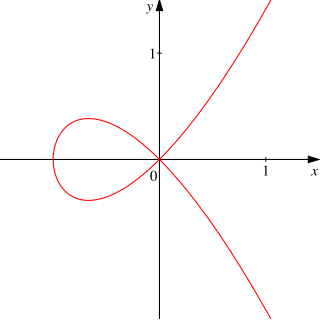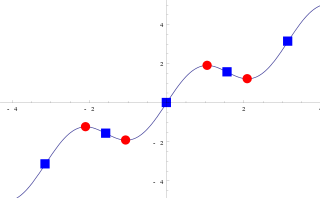
In mathematics, the derivative shows the sensitivity of change of a function's output with respect to the input. Derivatives are a fundamental tool of calculus. For example, the derivative of the position of a moving object with respect to time is the object's velocity: this measures how quickly the position of the object changes when time advances.
In mathematics, the determinant is a scalar value that is a function of the entries of a square matrix. The determinant of a matrix A is commonly denoted det(A), det A, or |A|. Its value characterizes some properties of the matrix and the linear map represented by the matrix. In particular, the determinant is nonzero if and only if the matrix is invertible and the linear map represented by the matrix is an isomorphism. The determinant of a product of matrices is the product of their determinants (which follows directly from the above properties).

In mathematics, a diffeomorphism is an isomorphism of smooth manifolds. It is an invertible function that maps one differentiable manifold to another such that both the function and its inverse are differentiable.
In numerical analysis, Newton's method, also known as the Newton–Raphson method, named after Isaac Newton and Joseph Raphson, is a root-finding algorithm which produces successively better approximations to the roots of a real-valued function. The most basic version starts with a real-valued function f, its derivative f′, and an initial guess x0 for a root of f. If f satisfies certain assumptions and the initial guess is close, then

In probability theory, a probability density function (PDF), density function, or density of an absolutely continuous random variable, is a function whose value at any given sample in the sample space can be interpreted as providing a relative likelihood that the value of the random variable would be equal to that sample. Probability density is the probability per unit length, in other words, while the absolute likelihood for a continuous random variable to take on any particular value is 0, the value of the PDF at two different samples can be used to infer, in any particular draw of the random variable, how much more likely it is that the random variable would be close to one sample compared to the other sample.
In vector calculus, the Jacobian matrix of a vector-valued function of several variables is the matrix of all its first-order partial derivatives. When this matrix is square, that is, when the function takes the same number of variables as input as the number of vector components of its output, its determinant is referred to as the Jacobian determinant. Both the matrix and the determinant are often referred to simply as the Jacobian in literature.
In the mathematical field of differential geometry, a metric tensor is an additional structure on a manifold M that allows defining distances and angles, just as the inner product on a Euclidean space allows defining distances and angles there. More precisely, a metric tensor at a point p of M is a bilinear form defined on the tangent space at p, and a metric tensor on M consists of a metric tensor at each point p of M that varies smoothly with p.
In mathematics, specifically differential calculus, the inverse function theorem gives a sufficient condition for a function to be invertible in a neighborhood of a point in its domain: namely, that its derivative is continuous and non-zero at the point. The theorem also gives a formula for the derivative of the inverse function. In multivariable calculus, this theorem can be generalized to any continuously differentiable, vector-valued function whose Jacobian determinant is nonzero at a point in its domain, giving a formula for the Jacobian matrix of the inverse. There are also versions of the inverse function theorem for complex holomorphic functions, for differentiable maps between manifolds, for differentiable functions between Banach spaces, and so forth.

In algebraic geometry, an affine algebraic set is the set of the common zeros over an algebraically closed field k of some family of polynomials in the polynomial ring An affine variety or affine algebraic variety, is an affine algebraic set such that the ideal generated by the defining polynomials is prime.
In mathematics, a submersion is a differentiable map between differentiable manifolds whose differential is everywhere surjective. This is a basic concept in differential topology. The notion of a submersion is dual to the notion of an immersion.
In algebra and in particular in algebraic combinatorics, the ring of symmetric functions is a specific limit of the rings of symmetric polynomials in n indeterminates, as n goes to infinity. This ring serves as universal structure in which relations between symmetric polynomials can be expressed in a way independent of the number n of indeterminates. Among other things, this ring plays an important role in the representation theory of the symmetric group.
In multivariable calculus, the implicit function theorem is a tool that allows relations to be converted to functions of several real variables. It does so by representing the relation as the graph of a function. There may not be a single function whose graph can represent the entire relation, but there may be such a function on a restriction of the domain of the relation. The implicit function theorem gives a sufficient condition to ensure that there is such a function.
In mathematics, a symmetric polynomial is a polynomial P(X1, X2, …, Xn) in n variables, such that if any of the variables are interchanged, one obtains the same polynomial. Formally, P is a symmetric polynomial if for any permutation σ of the subscripts 1, 2, ..., n one has P(Xσ(1), Xσ(2), …, Xσ(n)) = P(X1, X2, …, Xn).
In mathematics, specifically in commutative algebra, the elementary symmetric polynomials are one type of basic building block for symmetric polynomials, in the sense that any symmetric polynomial can be expressed as a polynomial in elementary symmetric polynomials. That is, any symmetric polynomial P is given by an expression involving only additions and multiplication of constants and elementary symmetric polynomials. There is one elementary symmetric polynomial of degree d in n variables for each positive integer d ≤ n, and it is formed by adding together all distinct products of d distinct variables.

Critical point is a term used in many branches of mathematics.
In mathematics, a change of variables is a basic technique used to simplify problems in which the original variables are replaced with functions of other variables. The intent is that when expressed in new variables, the problem may become simpler, or equivalent to a better understood problem.
In mathematics, a D-module is a module over a ring D of differential operators. The major interest of such D-modules is as an approach to the theory of linear partial differential equations. Since around 1970, D-module theory has been built up, mainly as a response to the ideas of Mikio Sato on algebraic analysis, and expanding on the work of Sato and Joseph Bernstein on the Bernstein–Sato polynomial.
In mathematics, a system of equations is considered overdetermined if there are more equations than unknowns. An overdetermined system is almost always inconsistent when constructed with random coefficients. However, an overdetermined system will have solutions in some cases, for example if some equation occurs several times in the system, or if some equations are linear combinations of the others.
In mathematics, a set of n functions f1, f2, ..., fn is unisolvent on a domain Ω if the vectors
In mathematics, Manin matrices, named after Yuri Manin who introduced them around 1987–88, are a class of matrices with elements in a not-necessarily commutative ring, which in a certain sense behave like matrices whose elements commute. In particular there is natural definition of the determinant for them and most linear algebra theorems like Cramer's rule, Cayley–Hamilton theorem, etc. hold true for them. Any matrix with commuting elements is a Manin matrix. These matrices have applications in representation theory in particular to Capelli's identity, Yangian and quantum integrable systems.















